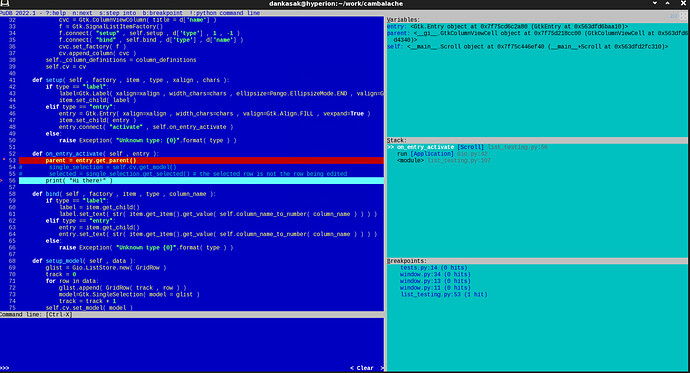For GtkEntry or GtkText we generally connect to the activate signal. I think GtkEditableLabel has only the changed signal. I have recently cleaned up my Nim GtkColumnView example a bit, for Python it may look similar:
import gintro/[gtk4, gobject, gio, glib, cairo]
import times
var qt = "GTKLV" & $epochTime()
if g_quark_try_string(qt) != 0:
qt = "NGIQ" & $epochTime()
let CVquark: int = quark_from_static_string(qt) # caution, do not use name Quark!
const
LayerNames = ["Ground", "Power", "Signal", "Remark"]
type
LayerRow = object
name: string
style: string
group: string
locked: bool
visible: bool
var
layers = newSeq[LayerRow](LayerNames.len)
proc initLayers =
for i, el in mpairs(layers):
el.name = LayerNames[i]
el.style = "default"
el.group = "G"
el.visible = true
type
ColumnViewGObject = ref object of gobject.Object
proc onSelectionChanged(self: SelectionModel; pos: int; nItems: int) =
echo "onSelectionChanged"
#echo pos, nItems
#echo typeof(cast[SingleSelection](self).getModel)
echo "bbb ", self.getSelection.maximum
proc onLayerNameChanged(w: Text) =
let row = cast[int](w.getQdata(CVquark))
layers[row].name = w.text
proc onStyleNameChanged(w: Text) =
let row = cast[int](w.getQdata(CVquark))
layers[row].style = w.text
proc onGroupNameChanged(w: Text) =
let row = cast[int](w.getQdata(CVquark))
layers[row].group = w.text
proc onLockedChanged(w: CheckButton) =
let row = cast[int](w.getQdata(CVquark))
layers[row].locked = w.active
echo layers
proc onVisibilityChanged(w: CheckButton) =
let row = cast[int](w.getQdata(CVquark))
layers[row].visible = w.active
proc draw(d: DrawingArea; cr: cairo.Context; w, h: int) =
echo "draw", w, " ", h
cr.setSource(1, 0, 0)
cr.paint
proc setup0(f: SignalListItemFactory; item: ListItem) =
let l = newLabel()
item.setChild(l)
proc setup1(f: SignalListItemFactory; item: ListItem) =
let l = newText()
l.connect("activate", onLayerNameChanged)
item.setChild(l)
proc setup2(f: SignalListItemFactory; item: ListItem) =
let l = newText()
l.connect("activate", onStyleNameChanged)
item.setChild(l)
proc setup3(f: SignalListItemFactory; item: ListItem) =
let l = newText()
l.connect("activate", onGroupNameChanged)
item.setChild(l)
proc setup4(f: SignalListItemFactory; item: ListItem) =
let l = newCheckButton()
l.connect("toggled", onLockedChanged)
item.setChild(l)
proc setup5(f: SignalListItemFactory; item: ListItem) =
let l = newCheckButton()
l.connect("toggled", onVisibilityChanged)
item.setChild(l)
proc setup6(f: SignalListItemFactory; item: ListItem) =
let l = newDrawingArea()
l.setContentWidth(4)
l.setContentHeight(4)
l.setDrawFunc(draw)
item.setChild(l)
proc bind0(f: SignalListItemFactory; item: ListItem) =
let l = Label(item.getChild())
l.text = $item.getPosition
proc bind1(f: SignalListItemFactory; item: ListItem) =
let l = Text(item.getChild())
l.setQdata(CVquark, cast[pointer](item.getPosition))
l.text = layers[item.getPosition].name
proc bind2(f: SignalListItemFactory; item: ListItem) =
let l = Text(item.getChild())
l.setQdata(CVquark, cast[pointer](item.getPosition))
l.text = layers[item.getPosition].style
proc bind3(f: SignalListItemFactory; item: ListItem) =
let l = Text(item.getChild())
l.setQdata(CVquark, cast[pointer](item.getPosition))
l.text = layers[item.getPosition].group
proc bind4(f: SignalListItemFactory; item: ListItem) =
let l = CheckButton(item.getChild())
l.setQdata(CVquark, cast[pointer](item.getPosition))
l.setActive(layers[item.getPosition].locked)
proc bind5(f: SignalListItemFactory; item: ListItem) =
let l = CheckButton(item.getChild())
l.setQdata(CVquark, cast[pointer](item.getPosition))
l.setActive(layers[item.getPosition].visible)
proc bind6(f: SignalListItemFactory; item: ListItem) =
let l = DrawingArea(item.getChild())
# e.g. double click on item
proc onColumnViewActivate(cv: ColumnView, pos:int) =
echo "onColumnViewActivate"
proc createLayersWidget: ScrolledWindow =
initLayers()
let cv = newColumnView()
cv.setHexpand
#cv.setSingleClickActivate(false)
cv.addCssClass("data-table") # [.column-separators][.rich-list][.navigation-sidebar][.data-table]
let c0 = newColumnViewColumn()
c0.title = "#"
let f0 = newSignalListItemFactory()
f0.connect("setup", setup0)
f0.connect("bind", bind0)
c0.setFactory(f0)
cv.appendColumn(c0)
let c1 = newColumnViewColumn()
c1.title = "Layer"
let f1 = newSignalListItemFactory()
f1.connect("setup", setup1)
f1.connect("bind", bind1)
c1.setFactory(f1)
cv.appendColumn(c1)
let c2 = newColumnViewColumn()
c2.title = "Style"
c2.setExpand
let f2 = newSignalListItemFactory()
f2.connect("setup", setup2)
f2.connect("bind", bind2)
c2.setFactory(f2)
cv.appendColumn(c2)
let c3 = newColumnViewColumn()
c3.title = "Group"
let f3 = newSignalListItemFactory()
f3.connect("setup", setup3)
f3.connect("bind", bind3)
c3.setFactory(f3)
cv.appendColumn(c3)
let c4 = newColumnViewColumn()
c4.title = "Lock"
let f4 = newSignalListItemFactory()
f4.connect("setup", setup4)
f4.connect("bind", bind4)
c4.setFactory(f4)
cv.appendColumn(c4)
let c5 = newColumnViewColumn()
c5.title = "Vis."
let f5 = newSignalListItemFactory()
f5.connect("setup", setup5)
f5.connect("bind", bind5)
c5.setFactory(f5)
cv.appendColumn(c5)
let c6 = newColumnViewColumn()
#c6.title = "Vis."
let f6 = newSignalListItemFactory()
f6.connect("setup", setup6)
f6.connect("bind", bind6)
c6.setFactory(f6)
cv.appendColumn(c6)
cv.connect("activate", onColumnViewActivate)
let gtype = gObjectGetType()
var listStore = gio.newListStore(gtype)
for i in 0 .. LayerNames.high:
let o = newObjectv(ColumnViewGObject, gtype, 0, nil)
#o.name = Names[i]#.sample
#o.age = rand(18 .. 95)
listStore.append(o)
let model = cast[SelectionModel](newSingleSelection(cast[ListModel](listStore)))
model.connect("selection-changed", onSelectionChanged)
cv.setModel(model)
result = newScrolledWindow()
result.setChild(cv)
proc activate(app: Application) =
let window = newApplicationWindow(app)
window.title = "GTK4 & Nim"
window.defaultSize = (200, 200)
window.setChild(createLayersWidget())
window.present
proc main =
let app = newApplication("org.gtk.example")
connect(app, "activate", activate)
discard run(app)
main()
